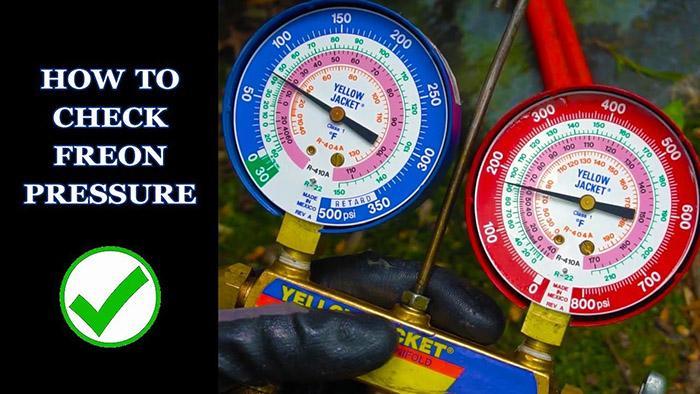The purpose of an air conditioner (AC) in a vehicle is to provide relief from the stress and irritation that comes with being stuck in traffic.
Every time an air conditioner is used, a substance known as refrigerant or Freon is introduced into the system in order to provide the users with cool and refreshing air.
You Are Watching: How To Check Freon Level In Car Updated 04/2024
The amount of refrigerant in your car’s AC decreases as you use it. As the refrigerant level in your AC drops, you’ll need to top it off to ensure that you’re getting the cool, refreshing air you’ve come to expect.
Low Freon levels might also lead to overheating problems and a malfunctioning air conditioner.
When it comes to checking the Freon level in your car, you’ve come to the perfect place. It’s not as difficult as it seems to check the Freon level in a refrigerator.
The method I’m about to describe is one of the simplest ways to check your car’s Freon level and determine whether or not you need to get it recharged.
Furthermore, a trip to a specialist is not necessary.
You can use a gauge to help you with this. Anywhere between 25 and 45 psi on the gauge indicates that you have an adequate amount of Freon in your vehicle.
If you don’t do what I tell you to do, I’ll use a gauge. It’s a simple process.
It’s important to understand fFeon’s inner workings before moving on.
What Is Freon, And How Does It Work?

In automotive air conditioning systems, Freon serves as a refrigerant and has been recognized as a trademark.
A trifluorinated combination of chlorine, carbon monoxide, and hydrogen sulfide makes up this refrigerant.
It is a gas at room temperature but rapidly changes to liquid when compressed or the temperature drops.
Odorless, colorless, and nonflammable are all characteristics of most commercially available Freon. If they come into touch with your eyes or skin, these compounds can be extremely harmful to you.
It is possible to go back and forth between a gaseous and a liquid form with Freon, a refrigerant.
When the conversion cycle in the air conditioner is complete, the Freon gas in the evaporator takes on a refreshing and cool form in the evaporator.
Evaporator fan takes outside air to cool down the Freon within, which cools it down due to its coldness. As a result, the automobile is filled with a cold and delightful breeze from the vents.
Now, let’s have a look at how to check the Freon level in your car.
Procedure To Check Freon Level In Your Car
You’ll need a thermometer, gloves, safety goggles, and an AC gauge before we get started. You can find them at any car-parts store in a matter of minutes.
Let’s begin the process:
1. Quick Inspection
I want you to put on your safety eyewear before you touch anything in your car.
Take a cursory glance at the air conditioning unit with the safety goggles on, looking for loose clamps and leaks if necessary.
You can save money by replacing any loose clamps with new ones. However, if you notice any leaks, it’s better to get in touch with a skilled mechanic.
Your following stage is complete if there is no sign of leakage.
2. Connect Service Ports With The Gauges
Read More : 10 Best Dent Pullers That You Need Know Updated 04/2024
Two service ports are visible in the car: one with low pressure and the other that has high pressure.
These ports can be found all around the world. I’ve made it easy for you to find them if you continue reading.
Low-pressure port is located between the compressor and accumulator (on the passenger side of the firewall) and is visible.
While this is going on, the high-pressure port is sandwiched in between the evaporator and the condenser (located right in front of the radiator).
If you’re having trouble locating them, your car’s owner’s manual might provide you with more specific directions. Once you locate the ports, you must connect the gauges to them.
3. Set The Highest Level Of Your AC (Max)
Begin the car and then turn on the air conditioner.
Various cars use different AC controllers, which have their own unique features. You can now use air recirculation if it is available to you.
The thermometer must be placed near the AC vent on the dash after the AC has been set to its highest setting.
Your system is operating normally if your temperature is 40 degrees Fahrenheit or lower.
4. Let The Compressor Cycle For A Few Minutes
Once the gauges are connected and the AC is adjusted, wait for the compressor to stabilize and cycle the pressure before taking the Freon or refrigerant measurement.
In most cases, the low-pressure port will read between 25 psi and 45 psi when it is being surveyed.
The gauge will give you a reading of between 250 and 400 psi when you measure the high-pressure port.
If the readings from the low- and high-pressure ports are both lower than normal, it’s likely that your Freon level is low.
Warning
Use items that are specifically designed for air conditioners. Always wear safety eyewear when working with pressurized systems. Always disconnect the gauges before starting the engine.
Car Ac Systems Require High Maintenance
Even if you don’t have time to inspect your car’s other components, you should not compromise on the air conditioning systems.
Your car’s performance is greatly influenced by this system.
Leaks can often be detected with just a fast visual inspection. Seals can come loose and fall off with time, allowing Freon to leak. Be sure to inspect these carefully.
In order to rid your air conditioner of impurities, do a short service and inspection every three years.
Consider replacing other parts like the tubes, which can help remove potentially harmful particles and improve performance, as well.
In the long run, your AC system is put under a lot of stress because of the buildup of dirt in the air cabin.
After every 10,000 miles, you have the option of upgrading the airflow by replacing the cabin.
4 Symptoms Of Low Freon Level
If you notice that your air conditioner is blowing out a small amount of warm air, you may be running low on Freon.
In addition, certain symptoms may point to a low Freon level that necessitates recharging.
Reduced Cooling: A low Freon level could be to blame if your air conditioner isn’t cooling properly or working at all.
To activate your car’s air conditioning, the sound of a clutch engaging can be heard. The AC switch activates a clutch that measures the AC system’s pressure. Refrigerant levels are the primary purpose of the clutch. As a result, neither the pressure nor the clutch will engage when Freon levels are low. The system won’t be able to move air if the clutch doesn’t engage.
Low Freon level is indicated by an icy compressor or a touch of ice on the compressor. This is a warning indication. Your car’s AC system is left with nothing but water when you run out of Freon. Frozen water will begin to form if there is no refrigeration.
Read More : How Long Can You Leave A Car Without Starting It Updated 04/2024
Freon Leaks: Finding a refrigerant leak is a clear sign that you need to refresh your car’s system with Freon.
Getting your car fixed as soon as you notice a leak is the best course of action. It will always run out of Freon if you don’t fix it.
Why Does My Car AC Need A Freon Recharge?

Air conditioning units need to be recharged or serviced every year if you have one at home. The same holds true for your car’s air conditioning.
If you’re not getting cool, refreshing air from your vehicle’s AC, it’s time to recharge your AC.
Because of this, recharging your car’s air conditioning system is vital for both the vehicle and the air conditioning system. Your AC may need a recharge if it isn’t working properly.
Don’t overfill your Air Conditioning unit, even if you’re thinking about doing so. This might cause a serious problem for your vehicle.
Your car’s performance can be affected if you don’t recharge it with enough refrigerant. As a result, be sure to top off your air conditioner’s refrigerant reservoir.
Which Refrigerant Shall Be The Best For My Vehicle?
Three Freon versions are used by automobile manufacturers.
The oldest, cheapest, and most efficient refrigerant is R12, which is being used today. In the ’90s, it was a common feature on many old automobiles.
R134a is the second. This refrigerant is almost certainly in your automobile right now. As of 1994, this was by far the most often used refrigerant. In addition to CFC-12 and HFC-23, R134a also contains other greenhouse gases. Industries, on the other hand, have stopped using this refrigerant because of its dangers.
Refrigerant R1234yf, a new addition, replaces the dangerous R134a refrigerant in automobiles. Almost every county in the United States uses this refrigerant in its automobiles. That’s why you should consider using it.
Frequently Asked Questions
How Long Will The Freon Last In My Vehicle?
In contrast to a generator, an air conditioner does not have to run continuously. You only use it when it’s absolutely necessary, of course.
In addition to that, there are a number of variables that can affect how long the Freon or refrigerant lasts.
The frequency of Freon recharge isn’t necessary if you reside in a chilly climate. Because you don’t use the AC as much when you live in a place with colder temps.
Also, if you have a problem with your AC system, such as a leak in the refrigerant, the Freon will be used up quickly. This will necessitate frequent Freon recharges.
What Makes My Air Conditioning System Leak?
This is why it is important to know the age of your air-conditioning system if you are trying to figure out what causes your air-conditioning system to leak.
You may have to replace the rubber clamps on your system because they lose their hold over time, allowing Freon to escape and moisture to enter.
Freon can become acidic if water is mixed with it, causing corrosion throughout the system and damaging the components.
Is It Safe To Check My Car’s Freon Level On My Own?
You can, in fact, check the Freon level in your automobile on your own. A few simple tools and safety precautions are all you’ll need. Then, all you need is a little bit of technical know-how and an idea to get the job done.
However, if the engine is still running and hot, avoid touching it. Begin only after the engine has cooled down to a safe temperature. Keep your hands and eyes protected by using gloves and safety glasses, and keep a safe distance from the object at hand.
Conclusion
Now that you’ve finished reading this post, it’s not out of the question to assume that it has helped you in some way. A Freon recharge is a must for any car.
If your air conditioner does break down, knowing how much Freon is in the system might save you a lot of money in the long run.
In this article, I’ve outlined the simple actions you may take to check your car’s Freon level..
A low Freon level in your car might cause several symptoms, some of which I’ve included here.
Freon levels are low if the AC is blowing warm air, then you must find out what’s causing these AC problems. There are a lot of options.
Sources: https://micdot.com
Category: Car










